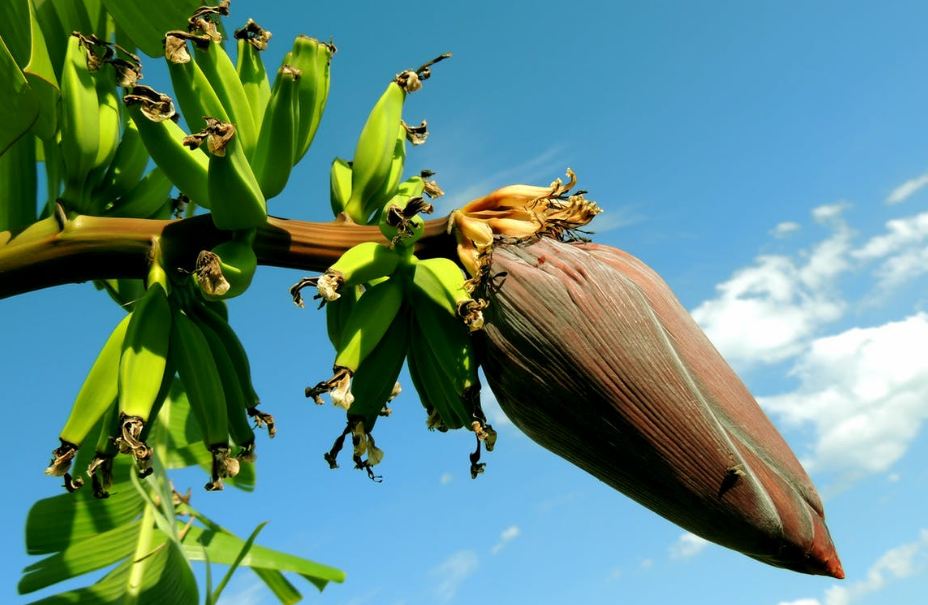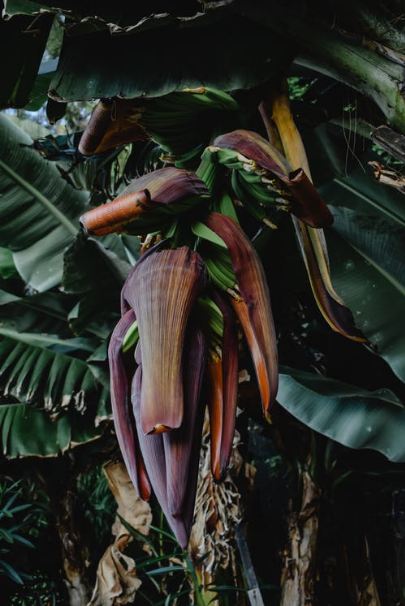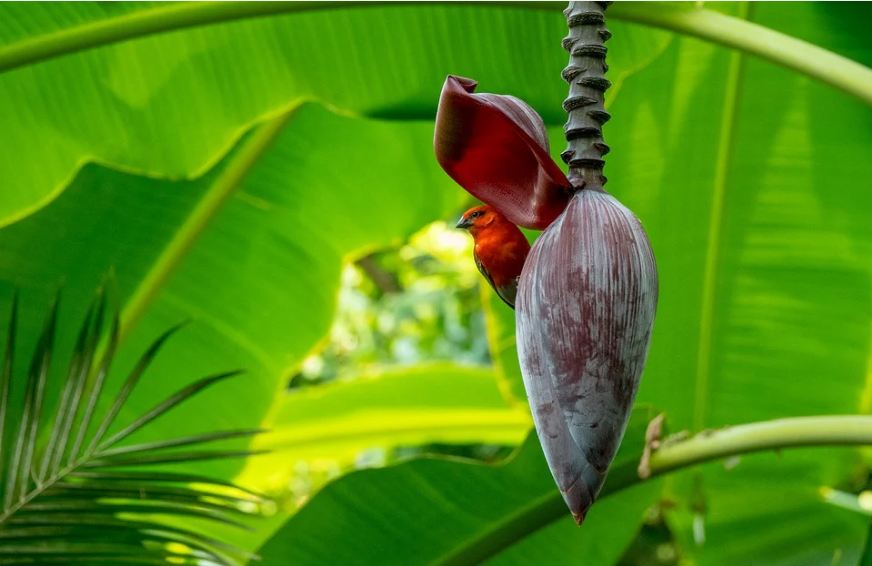Banana flowers, also called banana blossoms, are precisely what the name tells you. They are an edible intricacy, and you can find fresh ones at the stands on the side of the road and farmer markets or wherever bananas are grown. They are mostly grown in Asia and are commonly used to make salads, curries, and soup.
If banana flowers are left on the tree, they would probably turn into bananas. They grow in a group of peaks known as hands, and as the bananas are edible, they are sometimes called banana hearts. These banana flowers are reddish-purple with teardrop-shaped leaves that weigh up to one pound. To get the good stuff from the inside, you need to do some work.
The most intricate parts of the banana flower-like yellowy-white florets require removing, cleaning, and soaking in acidic water to lessen their bitterness. The intermediary leaves that are pale pink are also edible, and you should wash them too.
Taste of Banana Flowers
Although banana flowers’ taste is not similar to the bananas, they smell identical to the bananas. These banana flowers are very soft and much less banana-like when they are in the blossom form. Some people say that these flowers taste like artichoke leaves, and others feel that they taste like hearts of palm or bamboo shoots.
Regardless of what people say, they have an evocative and subtle taste similar to the relationship of flavor between the zucchini blossoms and full-grown zucchini. They are very soft and offer a little bit of crunchiness.
Steps for Getting Best Banana Blossoms
1. Choosing a Firm Banana Blossom
When choosing a banana blossom, make sure that you select the firm and tightly packed petals. They should be purple-red, and there should be no signs of decay. If you are not using the petals, you should wrap them up in a plastic wrap or cling film to keep the petals completely closed and store them in a refrigerator.
2. Remove and Soak the Yellow-Tipped Florets
There are tough reddish leaves on the exterior that are known as bracts. You can use these bracts on serving plates, or if you don’t need them, discard them. Below these “bracts” is a row of soft leaves that you can remove and immediately soak in the acidic water to prevent discoloration and bitterness.
3. Pluck The Matchstick Shaped Pistil
The colorful florets will soon eventually become bananas and are part of the long and tiresome cleaning process. You can pluck the matchstick shaped pistil and the scale-like outermost petal that is also known as calyx. You have to do this for every flower.
Discard them and soak the clean flowers in the acidic water immediately for a few hours or overnight to avoid browning and remove the bitterness. Clean it with cold water, drain it, and squeeze out the excess water.
4. Peel the Dark Bracts
The intermediary leaves that are pale pinkish are edible and tender. As you peel the dark bracts, you will reach a heart that is either white or pale-colored. You can trim the conical stem and throw it away.
Once you slice the stems in half lengthwise, it will produce a white sticky sap. Soak it immediately in acidic water and sit for about two hours to remove the bitter liquid and prevent browning.
5. Chop the Heart
The tender pale heart’s texture is somehow similar to the difference between tender artichoke leaves and bamboo shoots. Once you finish chopping the heart, it will look broken up in the chopped florets and pieces. You can then use this in soups, salads, curries, stews, and many more things.
6. Use a Natural Oil to Prevent Stains
Banana hearts are a bit difficult to clean because of the black sap that comes out of them. To prevent these stains, you can use any neutral oil and rub it all over your hand before handling the blossom. You can use an old cutting board and a little bit of oil on your fingertips to make the cleaning easier. The flower won’t get messy when you apply oil to it.
Cooking with Banana Flowers
There are many ways of cooking banana flowers. Here are some of them:
Peel the Outer Covering
It is not that easy to cook with banana flowers as adding them to a dish or a pot. It is not very fruity or flowery; instead, it adds a subtly sweet and floral tropical taste. You need to remove the darker outer covering of the banana flower to get to the tender yellow-green leaves present inside. You can also use the darker leaves as little serving boats if you like.
Salads
You can chop the youngest freshet specimens and use them in salads. You can also try adding the flowers to the spinach salads with a simple dressing and topping it with a chopped macadamia nut. Moreover, you can also use banana salads in soups or slices and add them to stir-fries. The green-colored banana flowers will cook fast and lose quite a bit of volume in the cooking process.
Steaming them
You can also steam the banana flowers and peel them apart like artichokes and serve them with dips. Like bananas, the banana flower leaves will turn brown or black if you leave them in the open air for a long time. Therefore, you should not peel the outer layer until you are ready to use them.
Benefits of Banana Flowers
According to case studies (case study 1, case study 2), here are some of the top health benefits of banana flowers:
1. Help in Treating Infections
Banana flowers help a lot when it comes to treating infections because they have ethanol extracts. These flowers prevent harmful bacteria from growing, including bacillus, subtilis, bacillus cereus, and Escherichia coli. Banana flowers also help in healing the wounds. A study says that banana flowers extract prevents the malarial parasite plasmodium falciparum’s growth into vetro. But these claims are still unproven.
2. Helpsin Reducing Free Radical Activity
Banana flowers also help in reducing free radical activity. The presence of these free radicals in the body can cause a lot of health problems. But luckily, the methanol extracts that are present in banana flowers have antioxidant properties.
These flowers are excellent in handling harmful free radicals that can damage the human body. It can treat many health-related issues like premature aging and cancer. You can include this in your health supplements to make full use of the antioxidant properties of flowers.
3. Helps in Managing Diabetes and Anemia
Banana flowers also help in managing the symptoms of diabetes and anemia. They aid in reducing blood sugar levels and increasing the overall hemoglobin levels in the human body. But for some reason, in the case of antimicrobial activity, the hypoglycemic effects of banana flowers haven’t been clinically proved yet.
4. Excellent Source of Vitamins And Minerals
Banana flowers are very rich in vitamins and minerals. They contain Vitamin A, C, and E and potassium and fibers. These vitamins and minerals in the banana flowers make them a great healthy food to eat. You can use these flowers as part of your supplements.
5. Enhances Mood And Reduces Anxiety
Banana flowers also help in mental health problems like anxiety and depression. These flowers are also an alternative for anti-depressants as they contain magnesium that reduces stress and improves mood. They are a natural treatment of anxiety and depression, and there are no side effects of banana flowers.
6. Helps Indigestion
Banana flowers help resolve digestive problems. They are alkaline food that considerably neutralizes the stomach’s acid secretions and provides relief from problems like indigestion, ulcers, and pain for a short time. Other than that, they are high in dietary fiber and other vital nutrients.
These flowers work as a natural laxative and regulate bowel functions and help in treating constipation.
Banana Blossoms – An Excellent Source of Healthy Nutrition
Banana flowers are a great source of vitamins and minerals, and you can make them a part of your daily supplements. They also have many health benefits, including lowering blood sugar levels, mood improvements, reducing free radicals, reducing anxiety and depression, etc.
They are also delicious, and you can use them in making dinner, soup, and salads.



